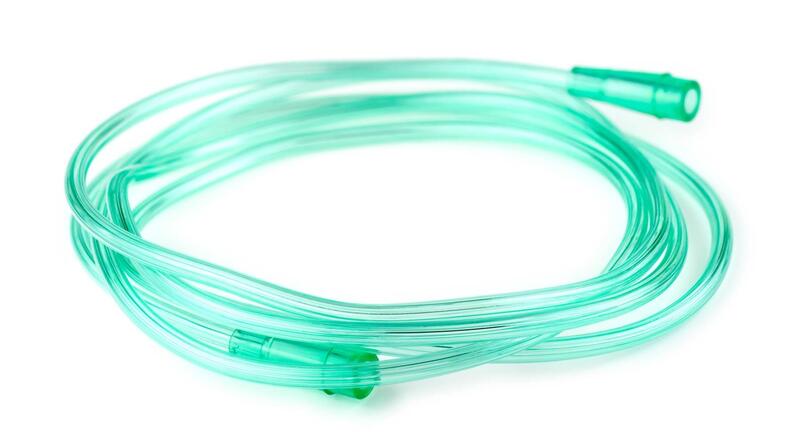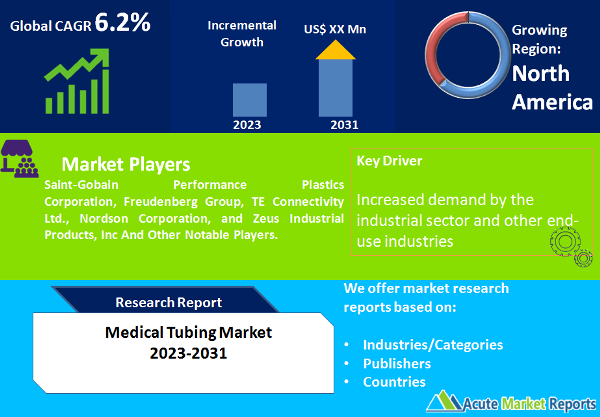
The medical tubing market is experiencing steady growth, driven by the increasing demand for healthcare services and advancements in medical technology. The market revenue has been consistently rising as medical tubing finds extensive applications in various medical procedures and devices. Medical tubing is utilized in a wide range of medical applications, including fluid management, drug delivery systems, catheters, respiratory and anesthesia devices, and surgical instruments. The tubing is designed to meet stringent regulatory requirements, ensuring safety, compatibility, and reliability in medical settings. The global medical tubing market is projected to grow at a CAGR of 6.2% during the forecast period of 2025 to 2033. Key factors contributing to the growth of the medical tubing market include the growing elderly population, rising prevalence of chronic diseases, increasing healthcare expenditure, and technological advancements in medical procedures. Additionally, the demand for minimally invasive surgeries and the development of innovative medical devices further drive the market's expansion.

Growing Demand for Minimally Invasive Surgeries
Minimally invasive surgeries have gained significant popularity in recent years due to their advantages such as smaller incisions, reduced trauma, faster recovery times, and lower risks of complications. This has led to an increased demand for medical tubing in procedures such as laparoscopy, endoscopy, and catheter-based interventions. According to a study published in the Journal of Laparoendoscopic& Advanced Surgical Techniques, the global market for minimally invasive surgical instruments, including medical tubing, is projected to grow at a CAGR of 9.5% from 2021 to 2026. The American Society for Gastrointestinal Endoscopy reported that the demand for endoscopic procedures is rapidly increasing, driving the need for specialized medical tubing that can deliver imaging systems, therapeutic devices, and guide wires.
Advancements in Medical Technology
Advancements in medical technology have significantly impacted the medical tubing market, driving the development of innovative materials, designs, and functionalities. These advancements enable enhanced performance, biocompatibility, and sterilization capabilities of medical tubing, catering to the evolving needs of healthcare professionals and patients. The introduction of advanced materials such as polyurethane, silicone, and thermoplastic elastomers has improved the flexibility, durability, and biocompatibility of medical tubing. This allows for improved patient comfort and reduces the risk of complications. Innovations in manufacturing processes, such as extrusion technologies, have enabled the production of complex tubing designs with precise dimensions and performance characteristics.
Increasing Prevalence of Chronic Diseases
The rising prevalence of chronic diseases, including cardiovascular disorders, respiratory conditions, and diabetes, has contributed to the growing demand for medical tubing. These conditions often require long-term monitoring, drug administration, and supportive care, which rely on the use of medical tubing for fluid management, drug delivery, and respiratory support. The World Health Organization (WHO) reports that chronic diseases are the leading cause of mortality worldwide, accounting for approximately 71% of all deaths globally. This indicates a significant patient population requiring ongoing medical interventions, including the use of medical tubing. The American Diabetes Association states that the number of people with diabetes is expected to rise to 700 million globally by 2045. This will drive the demand for insulin delivery systems, which rely on medical tubing for precise and controlled administration.
Stringent Regulatory Requirements and Compliance Challenges
The medical tubing market faces the challenge of stringent regulatory requirements and the need for compliance with various standards and guidelines. These regulations aim to ensure the safety, efficacy, and quality of medical devices, including medical tubing. However, they can pose challenges for manufacturers in terms of product development, testing, documentation, and obtaining regulatory approvals. The U.S. Food and Drug Administration (FDA) has established rigorous regulations for medical devices, including medical tubing, under the Code of Federal Regulations (CFR) Title 21. Compliance with these regulations requires manufacturers to meet specific performance standards, conduct extensive testing, and maintain comprehensive documentation. The European Union's Medical Device Regulation (MDR) and In Vitro Diagnostic Regulation (IVDR) have introduced stricter requirements for the certification and CE marking of medical devices, including medical tubing. Manufacturers need to demonstrate conformity with essential requirements and undergo clinical evaluations, adding complexity to the regulatory process. The International Organization for Standardization (ISO) standards, such as ISO 13485 (Quality Management System for Medical Devices) and ISO 14971 (Risk Management for Medical Devices), impose stringent requirements for quality management, risk assessment, and traceability of medical tubing, further adding to compliance challenges.
These regulatory requirements increase the time, resources, and costs associated with bringing medical tubing products to market. Manufacturers need to invest in robust quality management systems, conduct extensive testing and validation, and navigate the complex regulatory landscape to ensure compliance. Non-compliance can lead to delays in product launches, recalls, or penalties, affecting market competitiveness and profitability.
Silicone Tubing: Highly Prevalent and Revenue Leader in the Medical Tubing Market
Silicone tubing is a highly prevalent product type in the medical tubing market, renowned for its exceptional properties and diverse applications in the healthcare industry. With excellent biocompatibility, flexibility, and temperature resistance, silicone tubing is extensively used in various medical applications such as catheters, feeding tubes, respiratory devices, and fluid management systems. Its advantageous characteristics, including biocompatibility, flexibility, temperature resistance, and chemical resistance, contribute to its widespread adoption and preference among healthcare professionals and medical device manufacturers. Silicone tubing continues to play a crucial role in the medical tubing market, offering reliable and safe solutions for a range of medical procedures and patient care needs. Silicone tubing is known to have a significant revenue share in the medical tubing market. Approximations suggest that silicone tubing can contribute to a revenue share of around 35% in the overall medical tubing market. Fluoropolymer-based tubing, such as PTFE (polytetrafluoroethylene) and FEP (fluorinated ethylene propylene), is known for its exceptional chemical resistance and low friction properties. It is commonly used in catheters, implantable devices, and laboratory equipment. Fluoropolymer tubing holds a notable revenue percentage in the medical tubing market, driven by its specialized characteristics and applications. Fluoropolymer tubing expected to grow at a CAGR of around 8%.
Bulk Disposable Tubing: Highest Revenue and Steady Growth
The medical tubing market is segmented by application into bulk disposable tubing, drug delivery systems, catheters, biopharmaceutical laboratory equipment, and others. Each application segment serves specific purposes within the healthcare industry. Bulk disposable tubing refers to tubing that is used in large quantities and disposed of after a single use. It finds application in various medical procedures and fluid management systems. This segment is driven by the increasing demand for cost-effective and hygienic disposable products in healthcare settings. The bulk disposable tubing segment was the highest revenue generator in the medical tubing market in 2024. Medical tubing is used in various laboratory equipment within the biopharmaceutical sector, including chromatography systems, bioreactors, and filtration systems. These applications require tubing that can withstand harsh chemicals and maintain purity standards. The growth of the biopharmaceutical industry and the increasing demand for laboratory equipment contribute to the demand for medical tubing in this segment. The biopharmaceutical laboratory equipment segment is expected to exhibit a high CAGR in the medical tubing market during the forecast period of 2025 to 2033.
North America Remains as the Global Leader While Asia Pacific to Lead the Growth
North America held the highest revenue percentage in 2024 in the medical tubing market, driven by advanced healthcare infrastructure, technological advancements, and a large customer base. The region is home to several key market players and has witnessed increasing adoption of innovative medical devices and procedures. The United States, in particular, is a major contributor to the revenue in this market segment. The Asia Pacific region is witnessing significant growth in the medical tubing market, attributed to the rising population, increasing healthcare expenditure, and expanding healthcare infrastructure. Countries such as China, India, Japan, and South Korea are key contributors to the market's growth in this region. The demand for medical tubing in Asia Pacific is driven by the growing medical tourism industry, advancements in healthcare technologies, and the rising prevalence of chronic diseases.
Competitive Trends in the Medical Tubing Market
The medical tubing market is fiercely competitive, with several key players vying for market share and striving to stay ahead of the competition. Companies such as Saint-Gobain Performance Plastics Corporation, Freudenberg Group, TE Connectivity Ltd., Nordson Corporation, and Zeus Industrial Products, Inc. are prominent players in the market. These companies are actively engaged in various strategies to maintain a competitive edge. One of the key competitive trends in the medical tubing market is product innovation. Market players focus on continuous research and development to introduce advanced tubing materials with enhanced properties such as biocompatibility, flexibility, and resistance to chemicals and contaminants. They invest in cutting-edge technologies and collaborate with research institutions to drive innovation and bring novel products to the market.
Mergers and acquisitions are also common strategies employed by companies in the medical tubing market. By acquiring or merging with other companies, they aim to expand their product portfolio, geographical presence, and customer base. These strategic collaborations enable companies to leverage synergies, enhance their market position, and offer a comprehensive range of medical tubing solutions. Collaborations and partnerships are another important competitive trend in the medical tubing market. Market players collaborate with healthcare providers, research institutions, and other industry stakeholders to foster innovation, drive product development, and ensure regulatory compliance. By pooling their resources and expertise, companies can tackle complex challenges and develop advanced solutions that meet the evolving needs of the healthcare industry. Expansion into emerging markets is also a focus for many medical tubing companies. These companies recognize the growth potential in emerging economies and are expanding their operations and distribution networks in these regions. By establishing a local presence, they can tap into the increasing demand for medical tubing and strengthen their market position. Customer-centricity is a crucial aspect of competitive strategy in the medical tubing market. Market players prioritize understanding the specific needs and preferences of healthcare providers and end-users. They offer customized solutions, provide technical support, and ensure prompt and reliable customer service to enhance customer satisfaction and loyalty.
Historical & Forecast Period
This study report represents analysis of each segment from 2023 to 2033 considering 2024 as the base year. Compounded Annual Growth Rate (CAGR) for each of the respective segments estimated for the forecast period of 2025 to 2033.
The current report comprises of quantitative market estimations for each micro market for every geographical region and qualitative market analysis such as micro and macro environment analysis, market trends, competitive intelligence, segment analysis, porters five force model, top winning strategies, top investment markets, emerging trends and technological analysis, case studies, strategic conclusions and recommendations and other key market insights.
Research Methodology
The complete research study was conducted in three phases, namely: secondary research, primary research, and expert panel review. key data point that enables the estimation of Medical Tubing market are as follows:
Market forecast was performed through proprietary software that analyzes various qualitative and quantitative factors. Growth rate and CAGR were estimated through intensive secondary and primary research. Data triangulation across various data points provides accuracy across various analyzed market segments in the report. Application of both top down and bottom-up approach for validation of market estimation assures logical, methodical and mathematical consistency of the quantitative data.
| ATTRIBUTE | DETAILS |
|---|---|
| Research Period | 2023-2033 |
| Base Year | 2024 |
| Forecast Period | 2025-2033 |
| Historical Year | 2023 |
| Unit | USD Million |
| Segmentation | |
Product
| |
Application
| |
|
Region Segment (2023-2033; US$ Million)
|
Key questions answered in this report